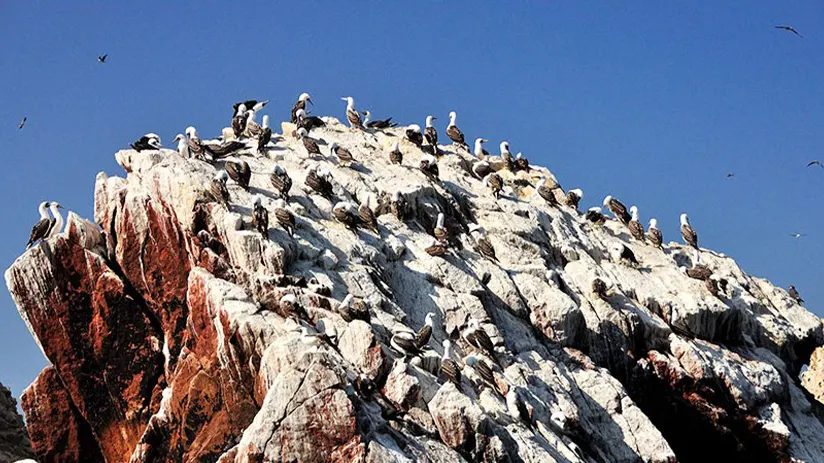The Ballestas Islands are proof of the incredible biodiversity in Peru. The Andean country is next to the Pacific Ocean on the west side. Mountains in the center also surround it. To the east, the government is bordered by the Amazon.
Peru has a variety of climates and landscapes, creating a diverse range of habitats for different species. For example, you can find penguins living on Peru’s dry and sunny coasts.
Can you imagine it? The Ballestas Islands are a great example of global biodiversity.
The experts at Machu Travel Peru will discuss Peru’s beauty and uniqueness and advise on the best ways to visit. They will explain why Peru is beautiful and what sets it apart. Additionally, they will offer tips on the most enjoyable ways to explore the country.
All need to know to have a complete experience in these wonderful Islands this 2024
- Ballestas islands overview
- Location
- History
- Sea life
- The Ballestas islands tour
- Best time to visit it
- How to get there
- Attractions around Ballestas islands
- Is it worth visiting?
Ballestas islands overview
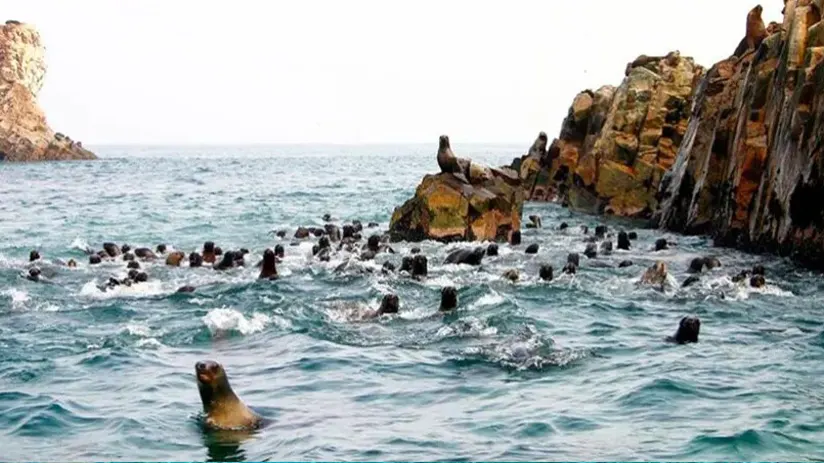
Ballestas Islands are a set of rocky islets full of wildlife, including penguins, cormorants, marine birds, and penguins. They all sing, repose over the rocks, and spread their wings within sight of onlookers. They are just on the Paracas Sea border, Pisco district, province of Ica, 03 hours south of Lima.
Of course, the experience is incomplete without the smell of guano (seabird droppings) that abounds in the islets. In the middle of the previous century, this input was important as a fertilizer for the crops of the Peruvian coast and highlands. For this reason, the Ballestas Islands are strongly related to Peru’s history.
But, rest assured. You will get used to the smell in a few minutes, leaving all your senses free to enjoy the landscape and contact with nature in these incredible islands.
Location
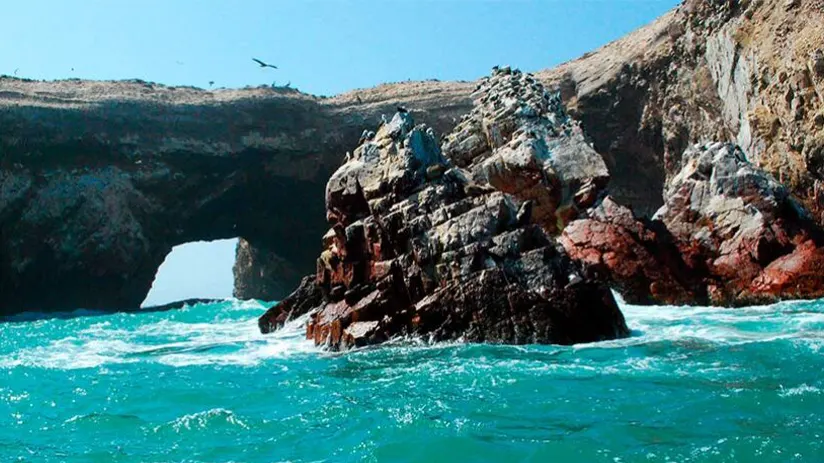
Paracas means sandstorms because the National Reserve is in an arid zone that borders the sea and receives disordered and tricky breezes over the sands.
The Ballestas are situated in the sea of Paracas, between Lima and Ica departments. 30 minutes by boat from Pisco province, 240 kilometers south of Lima, the capital of Peru, and 80 kilometers northwest of the Ica Department.
History
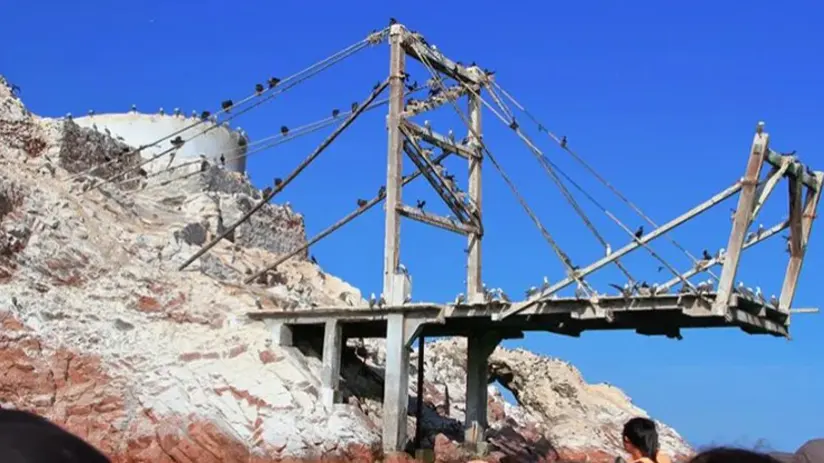
The guano or seabird droppings were extracted from Ballestas islands and were used as natural fertilizers around the world. The increase of organic food or productions cultivated with organic fertilizers promoted this input’s extract. However, the guano and the islands have a common past, that even involved a war between Peru and Chile. You will find a little timeline explaining it and other essential facts.
- Since ancient times, the Incas have known the benefits of Guano as fertilizer for their crops. Therefore, they have been using it and teaching their conquered peoples how to use it.
- 1800. From the middle of that century to the beginning of the 1900s, Guano was appreciated as a crucial organic fertilizer and agricultural input worldwide. Therefore, it was aggressively extracted in countries like Peru, and its price and demand rose, filling the vaults of the Peruvian government. For this reason, at the end of the 1800s, a war between Peru and Chile (the neighboring country to the south) occurred due to the control of Guano islands located in the zone of influence of both countries. But, this is another story.
- 1909. The demand for Guano decreased worldwide due to the discovery of synthetic fertilizers. Also, the Peruvian government created the Guano Management Company to promote the conservation of guano birds, protect them, and regulate the extraction of natural fertilizer. Some scholars affirm that before this year, layers of guano could be found between 20 and 70 meters thick, covering the rocky islets—unbelievable!
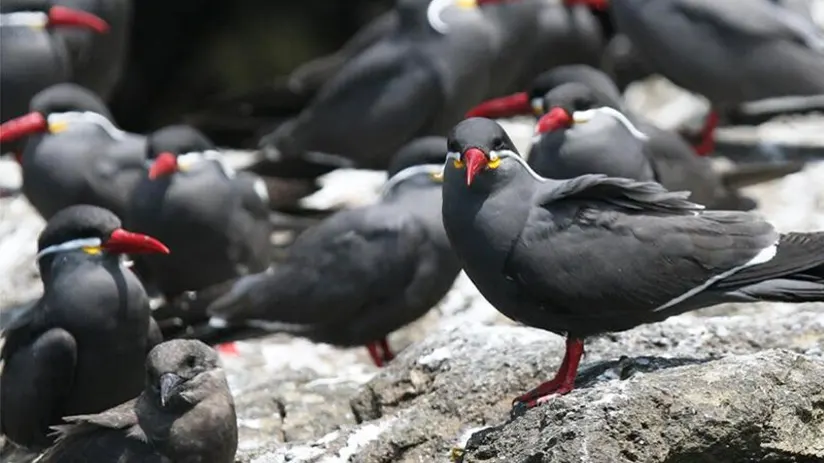
- 1975. The Paracas National Reserve was founded to protect the rest of the ancient pre-Inca culture of Paracas and promote the conservation of marine biodiversity in the Paracas peninsula. Although the Ballestas weren’t part of the national reserve, they were situated over its influence zone and received protection from it in some way.
- 2009, the National Reserve System of Guano Islands, Islets, and Points was created to receive more focused protection from the Peruvian government. In this sense, islets like the Ballestas, besides islands, coast rocks, beaches, and other geographical zones that contain marine life, were protected and regulated directly by the government.
- Nowadays, the Guano layers in the islets are thinner, and the extraction is limited to only three months of work. This is to avoid a significant and abrupt interruption to the area’s marine ecosystem.
Sea life
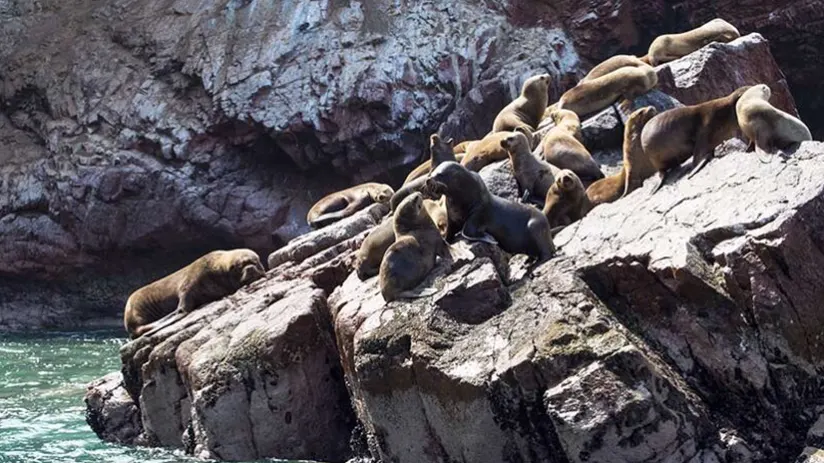
The diversity of wildlife in the Ballestas is amazing. With more than 200 species of migratory birds that make a stopover on the islets, without mentioning its permanent tenants like the Humboldt penguins, the Guanays, the Peruvian boobies, pelicans, kelp gulls, and Inca terns.
Therefore, the islands represent a true paradise of birdwatching in Peru. Of course, we don’t forget the dolphins and turtles which visit the islands periodically.
But, what do these birds eat? Well, the surface of islets and Paracas coasts are rocky and deserts, and nothing grow there, but if we look underwater, we’ll realize that more than 300 types of algae inhabit there, feeding the fish and shellfish. These, in turn, will be food for local birds, seals, and sea lions.
- Seals: The most abundant mammals in the zone usually rest over the rocky islets, communicating and growling. They show color variations like black, brown, and gray. The females weigh between 65 and 130 pounds and are smaller than the males, which weigh up to 420 pounds. They are not shy and are used to the human presence, like all the species of the place.
- Sea lions are the biggest mammals in the zone. They usually rest over islets among seals, living in perfect harmony. With brown bodies and big heads covered by golden hair reminiscent of lions, these animals reign over the islands. The males can weigh up to 750 pounds, and the females are smaller, around 370 pounds. The season for raising their puppies (January – March) coincides with perfect Peruvian weather for visiting the Ballestas Islands.
- Guanays: The responsible for guano over the islets for more than 600 years! Among local birds, these are the most numerous. They have a red circle around their eyes, elongated beak, black plumage with a white crop, and jowls. For this reason, these can be confused with Humboldt penguins in the distance.
- Peruvian boobies: These endemic birds of Peruvian and Chilean coasts are guano birds, too., and join the Guanays, are permanent inhabitants of Ballesta islands. They are 75 cm high and have a white head, neck, and crop, instead, their wings and tails are dark browns. Their cousins, the blue-footed boobies, live in the Galápagos Islands in Ecuador.
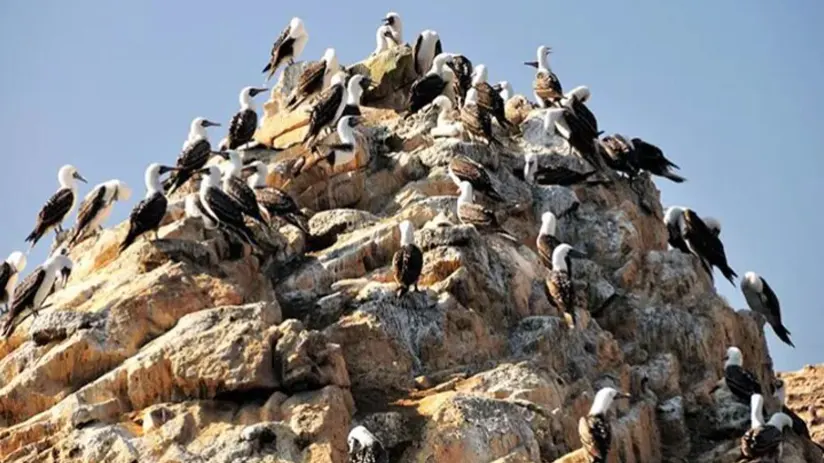
- Pelicans: This, maybe, is the most common seabird throughout the Peruvian coast. They have heads and backs of white color, and their wings vary from lead to black. The most essential characteristics of that group who live in the Ballestas Islands are their throat pouch, which is blue. In comparison to other pelicans which have white, olive, or lead throat pouches.
- Kelp gulls: They have white heads and bodies, with black wings. Their beaks are elongated and at the end of these, you can see a red dot, a unique characteristic among all seagulls. Outside Peru, these birds are called Dominican gulls, too.
- Inca terns: Without a doubt, these are the most colorful seabirds inside the islands, and seeing them is a real privilege. The birds have a head completely covered by black plumage, at the sides of its red beak that continue in an extension of yellow lips there are fine white feathers that resemble a long, curved mustache. The rest of its body is covered by lead plumage, without mentioning its red legs.
- Humboldt Penguins: We always associate penguins with ice, polar ice caps, or Antarctica, but the Humboldt’s penguins live throughout all dry, hot, and desert Peruvian coast. Unbelievable but true! But Why do they live in conditions like that? Well, the Humboldt Current is the answer, this cold current make floats underwater waters, showers the north coast of Chile and all Peruvian coast, and comes from south to north. This is rich in phytoplankton, herring, mollusks, and anchovies, the diet of Humboldt penguins that follow it to the Peruvian coast. These cute animals were named for the first time by the famous German naturalist Alexander von Humboldt, by the way.
- Sharks: If you were wondering about the existence of sharks in the Paracas sea and in the Ballestas, you are right, there are sharks. Happily, these don’t represent a danger to humans because they are shy, and very difficult to let themselves be seen unless you dive into the depths of the Paracas sea, but this practice is forbidden due to the Paracas national park being a protected zone. The species that you can find in Paracas are the Mustelous or Smooth-hound, besides the hammerhead shark.
The Ballestas islands tour
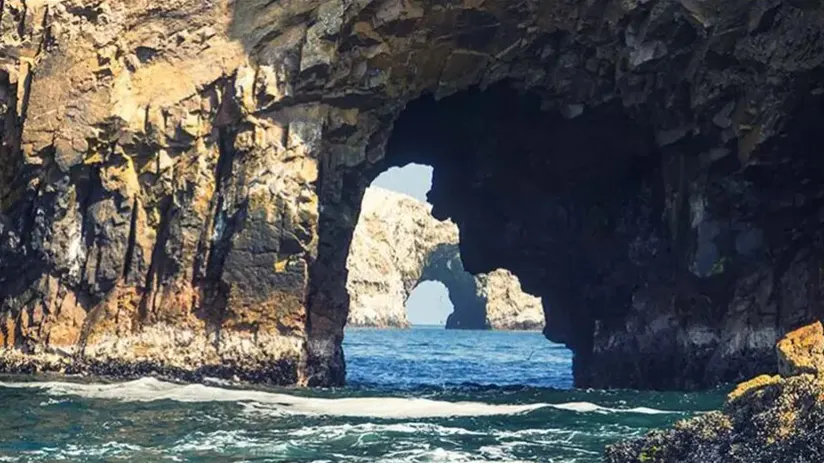
- The cost of transportation to get to Paracas (The closest point to begin a tour to the Ballestas) from Lima: Usually, the cost varies from around $11 – $16 per person on a Bus or Car, the distance is 260 kilometers, and takes 03 hours and a half tour. Soyuz, Cruz del Sur, Civa, and inter alia are the bus companies that offer transportation to Paracas.
- You can make a full-day Ballestas Island tour from Lima: But, take note that the duration trip from Lima to Paracas last 3 hours and a half, and the last boat to the islets depart at 10:30 am. In this sense, you will have to depart from Lima at 06:00 am approx.
- Cost of Ballestas Islands tour: Usually, the cost of a complete tour through the islets is $25.00 per person (be it an adult or a child). It includes a boat transportation service, life preservers (floats), and a tour guide.
- Entrance fee and tax: Besides paying for the tour, you will have to pay a port tax of $1.25 and a $3.00 entrance fee to the islands. And if you were wondering to make a reservation in advance to buy tickets to the islands, don’t worry, these can be purchased in the same port near the islands since there is no limit to visits per day.
- How long does the Ballestas tour last? The tour lasts 02 hours approx. going on the boat to the place, making a stopover to see the candelabrum and sailing among the islets, enjoying the wildlife, and landscapes, and returning to the port.
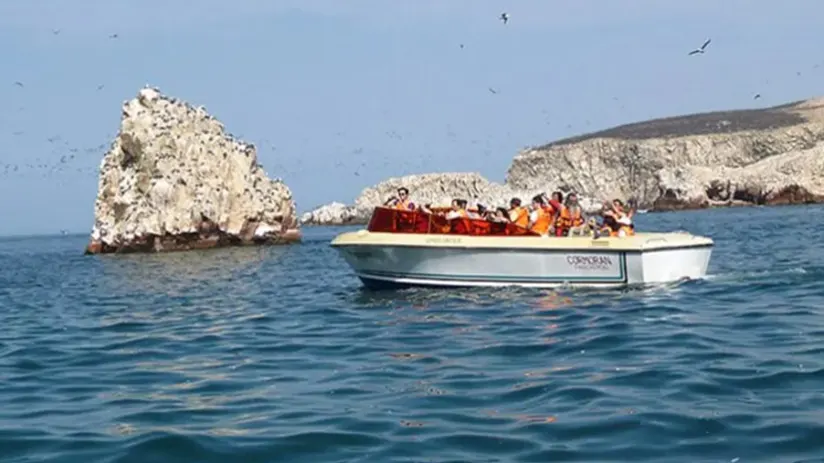
- You can suffer from dizziness: Remember that you’ll onboard visit the islets and the tides in that part of the sea are usually a bit high. We recommend you take a seasick pill 30 minutes before beginning the tour and breakfast something light.
- You can not disembark and walk over the islets or the Paracas coast. As we mentioned before, the islands are located inside the National Reserve System of Guano Islands, Islets, and Points. Therefore, all these areas are protected from direct human contact. You only can see them at an appropriate distance.
- Where to stay: As you will have noticed, the Ballestas Islands and the surrounding zone (Paracas coasts) are protected and there is not any hotel infrastructure. However, the local town of Paracas has quality hotels of 5 stars like Libertador Paracas resort or the Aranwa Paracas Hotel, to enjoy a couple of days, walking through the coast, enjoying a romantic dinner at night over on the beach. Therefore, among Pisco and Ica, spending nights in Paracas is worth it, definitely. Of course, in Pisco town where you’ll find more cheap hotels destined for tourists national, there you’ll enjoy the vineyards where Pisco is produced, the national drink.
Best time to visit it
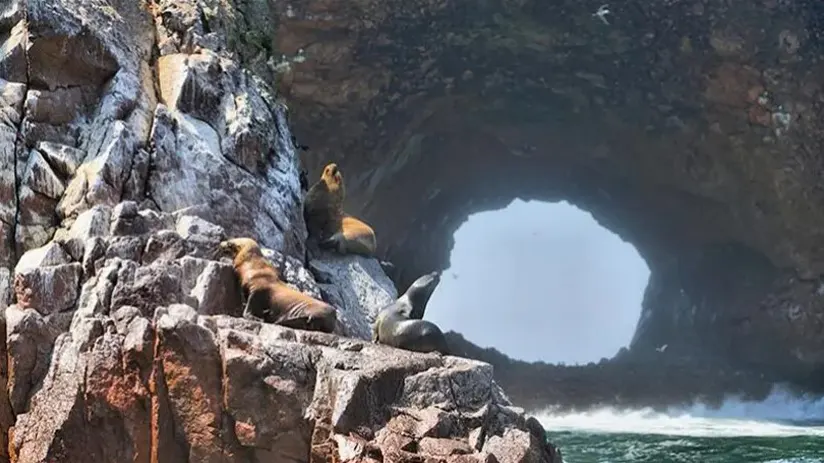
Usually, the best time to visit the Ballestas Islands is during the sea lion calving season, between January and March. You will see these nice little animals resting over the rocky islets, swimming, and climbing the rocks with their mothers. Also, this period coincides with the summer in Peru, half of December, January, February, and March, when the islands present a strong heat with clear skies and cold breezes.
Also, the islets generally have warm weather with scarce and small precipitations all year, with temperatures between 64 – 80 ºF. For this reason, it can be visited at any time, but if you ask us about our favorite time, the summer always will be the best.
How to get there?
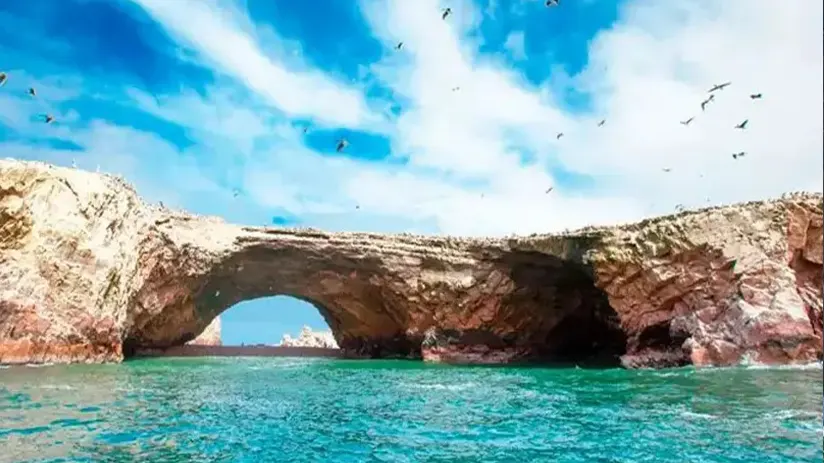
Fortunately, these rocks islands are surrounded by three important towns, where tour groups depart every day to enjoy their wildlife. The distance from Lima to Ballestas is 245 kilometers or 04 hours by car. But this distance is cut if you depart from the two closest towns. Let’s see.
- From Paracas town. It is the closest town and the best way to get to the Ballestas islands. If you are in its main square, you can join some tourist group that meets there (Previous booking) to go in a bus to the port, take a boat and sail for 2 hours to the islands. Or, if you prefer, you can wait in the same port for any tourist group for you to join. The last boat leaves the port at 10:30 am.
- From Pisco town: Pisco is the second-closest place to Ballestas, its sea is located just in front of the islets. The town is located 45 minutes north of Paracas town and if you take a boat from its port, you will sail around 30 minutes to Ballestas. The number of boats is less than what you find in Paracas, but the distance to the islets is short.
- From Ica city: If you are in Ica (Department capital), you can arrange a taxi to go to Paracas 01 hour from the Ica main square. On the other hand, you can arrange a taxi from the main square to Pisco, the tour takes 01 hours.
- From Lima, the Capital of Peru: If you are in Lima, so, your destiny is located in the south. You can go to Paracas and enjoy one of the best Nature Reserves in Peru, the car trip lasts three and a half hours traveling approximately 260 kilometers to get there. Now, if you want to add beautiful vineyards and the manufacture of the national spirit, Pisco, to your islet’s visit, you’ll have to go first to the town of the same name. The distance from Lima to Pisco is 235 kilometers or 03 hours by car or bus. Finally, you can go to the Capital of the department called Ica, to enjoy Huacachina oasis and its hotel infrastructure and by the way, visit the Ballestas. The time to get there takes 04 hours.
Now, Is it possible to visit these islands in one day from Lima? Yes, it’s possible, but take note that the last boat departs from the Paracas port at 10:30 am, counting the 03:30 hrs of trip from Lima to Paracas, you will have to depart from Lima at 5:30 am or 06:00 am as the maximum time.
Attractions around Ballestas islands
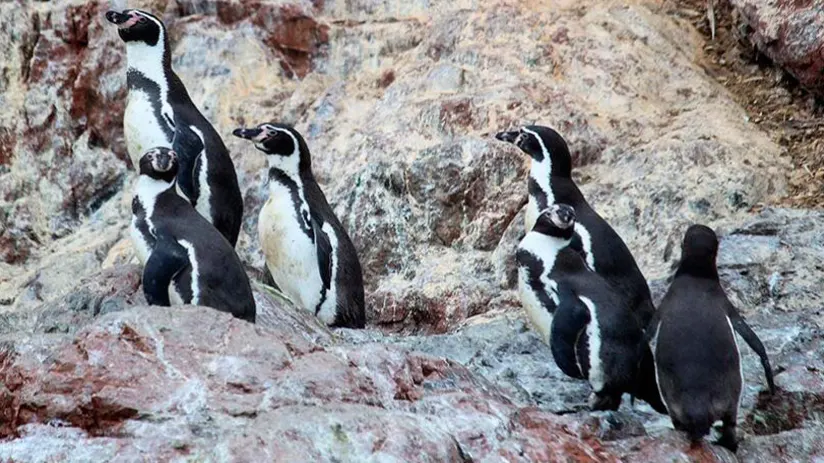
The Ballestas islands have to offer much more than wildlife, remember that the islands are in the zone of influence of the National Reserve of Paracas. This is a protected area of endemic and migrant birds, that contains a rich sea life (It is due to the Humboldt current) on its coast. Paracas is a local name given to sand storms, which frequently occur in the place, and to Paracas pre-Inca culture, an ancient civilization with advanced techniques of agriculture and medicine developed between 700 B.C and 200 A.C. in the zone.
Following, you will find two important places located around the Ballestas Islands.
A. Paracas National Reserve
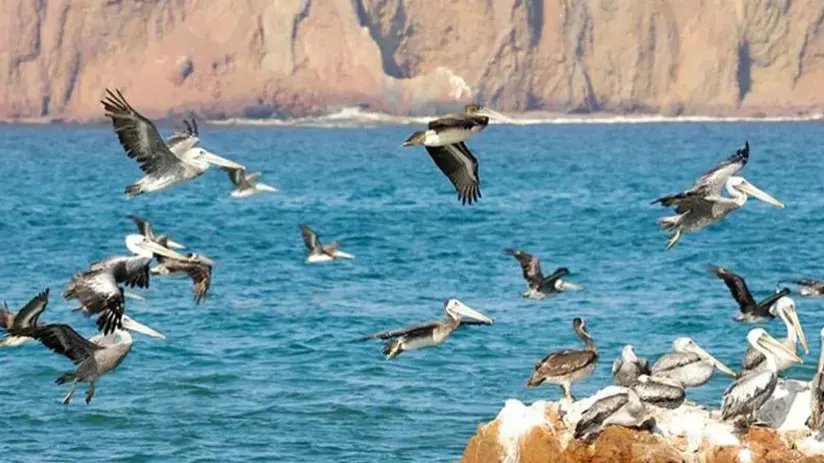
As its name indicates, the National Reserve is a protected zone for the conservation of endemic and migrant birds, besides the rich sea life of its coast. Therefore, entering for any person is forbidden (except scholars, and academics with special permission from the Peruvian government) to do research and studies. However, you can visit the main square of the local town to join a group of tourists heading the island and, by the way, visit the local museum located there, where you will see the lifestyle, uses and customs, cultivation techniques, and even cranial trepanations of the ancient culture that previously lived in the place, the Paracas culture. Without a doubt, one of the most interesting things to do in Paracas.
B. El Candelabro (The candelabrum)
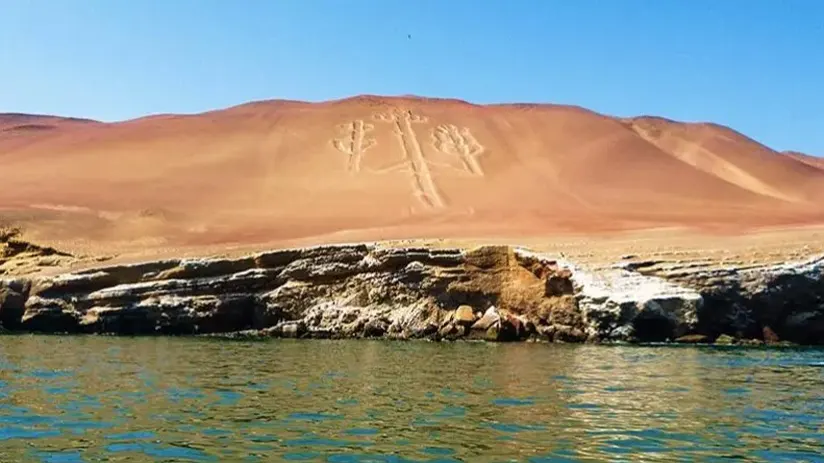
The zones around of Ballestas Islands have more mysteries to be discovered, and El Candelabro in Paracas National Reserve is one of these. Remember that a few meters away there are the Nazca Lines (130 miles of distance), but scholars affirm that the candelabrum is not part of the giant glyphs. This figure has more than 590 feet long and is situated over the slope of a sandhill to face the sea, where the winds are scarce and the sunshine extreme.
For this reason, its contours were maintained to this day and can be visible at 180 meters distance. The local people affirm that the figure was used as a diurnal lighthouse for fishermen and pirates in old times. This affirmation can be possible taking into consideration that the figure dates from 200 B.C. In the middle of the way sailing to Ballestas Islands and departing from Paracas, you’ll have the possibility to see it.
- What to carry and wear:
- Dry Bag to prevent your things from getting wet by the tides that sneak into the boat.
- Windbreaker for the cold blizzards that blow in that part of the sea.
- Sunscreen.
- Hat to prevent the excrement of birds that fly between islets, especially the famous Guanay.
- Camera with zoom.
- Binoculars.
- Life vest (Usually these are provided by the tour company)
Is it worth visiting?
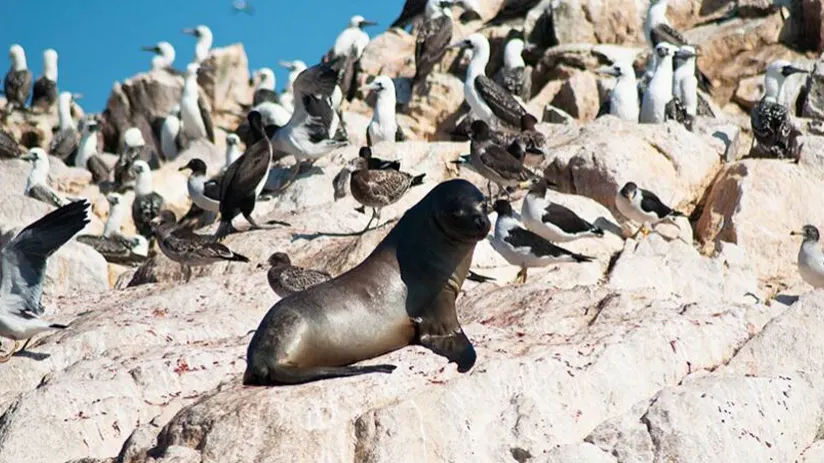
If we talk about tour experience quality inside Peru, the Ballestas Islands are situated together with Manu National Park or Tambopata National Reserve at that level. But why? because it is live nature in front of your eyes. There, you can see wildlife a few meters from you, without any mesh in between.
Only you and nature. If you ask us if it is worth visiting the Ballestas, definitely, yes, it’s worth it, and it should not be missing from your list of points to visit in Peru, in addition to Machu Picchu of course.
“THE JOURNEY OF A THOUSAND MILES BEGINS WITH A SINGLE STEP”
As you see, Peru has much more to offer than Machu Picchu and its great gastronomy. The wildlife and the big biodiversity distributed in its National Reserves and Parks like Manu, Tambopata, Pacaya-Samiria, Paracas, and Ballestas Islands among others, invite the visitant to discover the Andean country on all its sides. During the process, you will begin to know more about the world’s biodiversity, and who knows, more about yourself.
Come on, dare to discover more fantastic places with the assistance of the local experts of Machu Travel Peru. Our team is ready to listen, absolve your doubts and assure you of a great experience in Peru.
